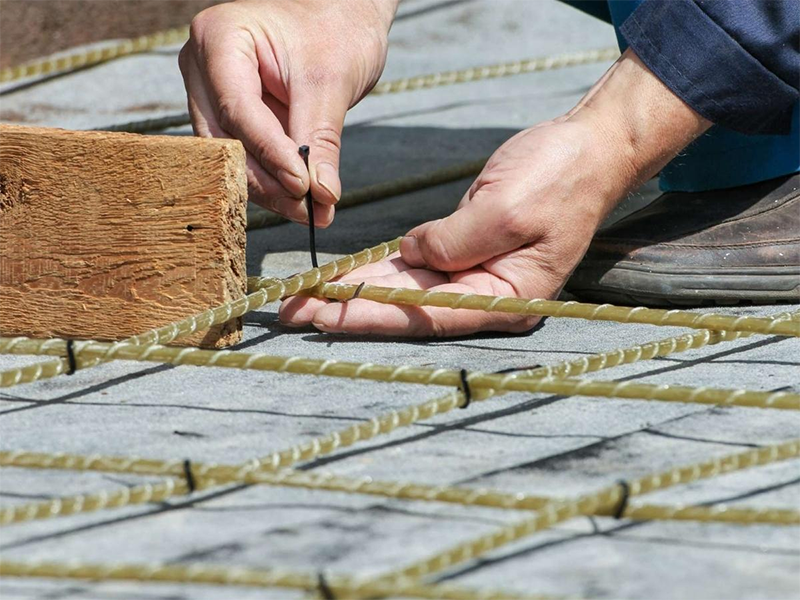FAQ's on GFRP
Frequently Asked Questions on GFRP Fiberglass Rebar.

Fiber glass rebar is a cost-competitive material compared to coated steel. If corrosion is not an issue or non-metallic reinforcement is not required, then steel may be a suitable option. Based on life cycle cost analysis, the use of "SAM-R" GFRP Rebar provides competitive prices, zero maintenance, excellent durability, and long design life. Using "SAM-R" GFRP saves in these areas: Reduced concrete coverage - extra concrete thickness is not required to protect the Rebar No allowances are needed for diameter reduction caused by corrosion. No expensive concrete waterproofing additives required No cathodic protection required Significantly cheaper than stainless steel Does not rely on surface protection like epoxy rebar, so does not need to be touched up after placement Zero maintenance costs GFRP rebar is 75% lighter than steel saves on freight, speeds up installation, and reduces labor requirements.
"SAM-R" GFRP Rebar has two modulus ranges, 46GPa and 60GPa. The range generally offers the designer a more cost-effective solution. Steel has a tensile modulus of 200GPa.
"SAM-R" GFRP Rebar is one of the highest strength composite rebars available, with a tensile strength of over 1000 MPa. This is over twice the tensile strength of steel rebar, which is typically 400 to 500 MPa.
The lower modulus can be overcome as "SAM-R" GFRP Rebar is corrosion-resistant. Large concrete coverage to provide protection is not required so fiberglass rebar can be placed closer to the surface. The increased distance from the neutral axis increases the sectional modulus. Due to the non-corrosive nature of "SAM-R" GFRP Rebar the crack-width allowance, as defined by ACI, is increased from 0.3mm to 0.7mm.
The modulus of "SAM-R" GFRP Rebar is over 60GPa, which is the theoretical limit for ECR glass-reinforced rebar. Other reinforcements can be used, such as carbon-fibre, aramid fibre, or S-glass. However, all these reinforcement options are expensive.
Fiberglass rebar is linear elastic to the point of failure, correct design methodology ensures the structure exhibits the desirable ductile failure mechanism. This is achieved by a balanced reinforcement design. The higher tensile strength of the reinforcement then forces a mechanism of progressive bond failure, which results in a ductile failure mode of the structure. American Concrete Institute ACI-440.11.2022 document provides further details.
Due to higher fatigue properties, GFRP Rebars have a higher resistance to cyclical loads of high intensity, which makes GFRF Rebars workable during earthquakes subject to a detailed design report on the same.
Both composite reinforcement and metal reinforcement have approximately the same adhesion to concrete/cement.
Composite reinforcement is fire-resistant up to 600 degrees Celsius. Once the temperature exceeds 600 degrees Celsius, the compound that binds the composite reinforcement fibres softens. Composite reinforcement does not burn directly, and studies show that structures are sustainable during a fire.
Indian standards of GFRP Rebars India are IS 18255 : 2023, IS 18256 : 2023, and IRC : 137 - 2022.
"SAM-R" GFRP Rebar is manufactured from a high-grade glass-fibre called ECR-glass. It is immune to alkaline attack.
"SAM-R" GFRP Rebar bends must be manufactured to shape at the factory. However, standard bend shapes are available.
As with steel and other rebar bends, the bent section of the GFRP rebar is not as strong as straights, but research is going on to overcome this issue.
On-site handling of fiberglass rebars is similar to steel. Contact your "SAM-R" GFRP Rebar representative for handling, safety, storage, and installation instructions.
With any rebar, significant damage must be addressed. Minor damage will not affect the performance of "SAM-R" GFRP Rebar as it does not rely on any form of coating to protect from corrosive elements.
You must design around the properties of GFRP rebar. The American Concrete Institute ACI-440.11.2022 committee is an excellent source of information and designers should familiarize themselves with ACIACI-440.11.2022 or similar guides. Find out about the latest codes and standards for GFRP rebar here. The "SAM-R" GFRP Rebar team is on-hand to work with design engineers if they need assistance in transitioning from steel to "SAM-R" GFRP Rebar.
"SAM-R" GFRP Rebar provides a corrosion-free rebar alternative with an extended asset lifespan in the most challenging and corrosive environments. If the issue of corrosion is present in any project, "SAM-R" GFRP Rebar is considered a superior alternative to steel—eliminating the risk of corrosion and associated maintenance costs. It does not need protective coating or cathodic protection. "SAM-R" GFRP is non-metallic making it ideal for environments where conductivity poses a safety risk or interference to sensitive equipment. "SAM-R" GFRP can be safely used near MRI scanners in hospitals, light rail projects, airport compass calibration pads, and electrical substations.
GFRP stands for Glass Fibre-Reinforced Polymer (commonly called Fiber glass). GFRP rebar has proven to provide the best price-performance ratio of all the different fibres, so it is the most commonly used material in the composites industry. FRP stands for Fibre Reinforced Polymer, which encompasses other fibers such as basalt (BFRP) and carbon (CFRP).
Absolutely, you can use Sea sand with SAM-R GFRP Rebar because it is Highly Corrosion Free.



